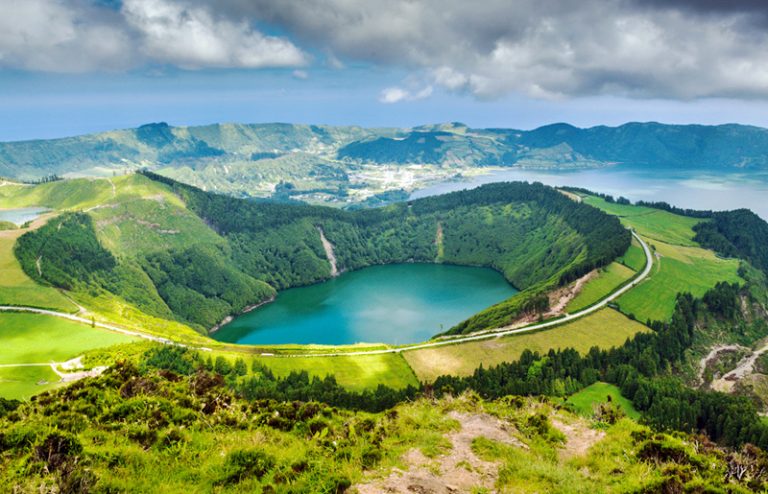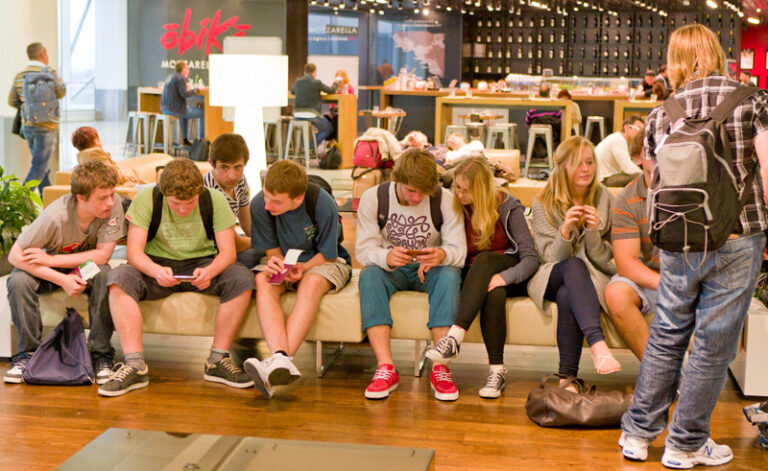Why did the Iceland Volcano Erupt? A Look Into The Litli-Hrutur Eruption 2023
On 10th July 2023, a new volcanic eruption began in Iceland, following seismic unrest and ground deformation. But what caused Litli-Hrutur to erupt?
In this post, we’ll provide some context into the causes, impacts and mitigation so far.
Short on time? Here’s everything you need to know
- Iceland straddles two continental plates, the North American and Eurasian plates, and sits above a hotspot. Slab pull drives tectonic plate movement alongside ridge push and convection which makes it a hotspot for volcanic activity
- Litli Hrútur is part of the Fagradalsfjall volcanic complex in Reykjanes and this is the third eruption in this area since 2021
- The eruption is effusive, with thin basaltic lavas forming fire fountains and lava flows along a fissure within an unhabituated valley
- 7 days of increasing seismic activity preceded the eruption (a much shorter build-up than usual)
- Seismic activity decreased 2 days before the eruption, and deformation rates slowed as magma reached shallow depths, until a sudden heightening of activity immediately before magma broke the surface
- Key hazards so far are lava flows, toxic volcanic gases, and smoke from grass fires
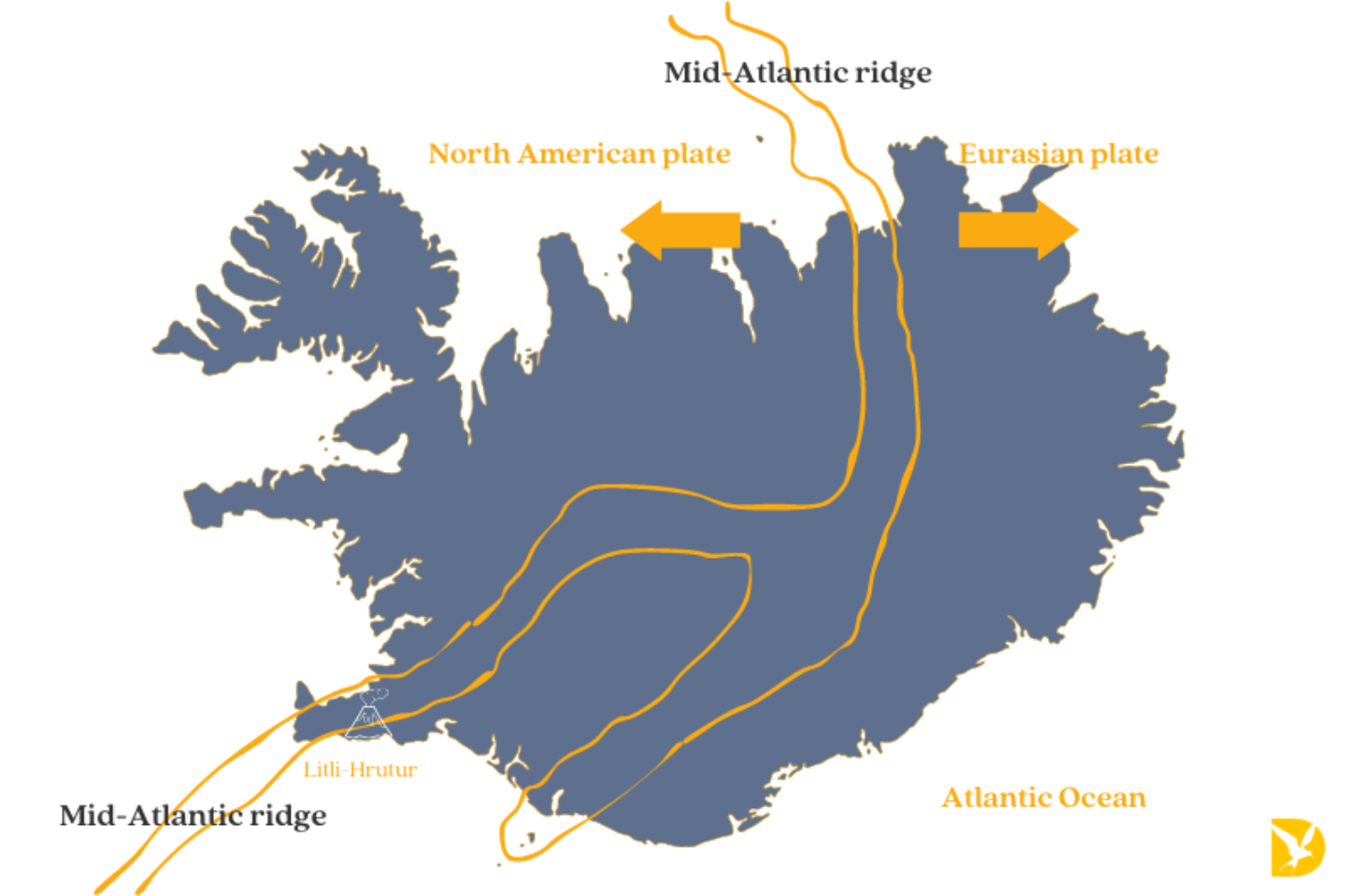
Why did the Iceland volcano erupt?
Being located along the Mid-Atlantic Ridge, a zone of seafloor spreading Iceland is no stranger to earthquakes and volcanism.
Leading up to the Litli Hrutur eruption, scientists predicted possible eruptions after hundreds of minor earthquakes were detected in recent weeks before. Location is key when it comes to why Iceland is a volcanic hotspot.
Sitting above the ‘Iceland plume,’ eruptions occur due to slab pull. Slab pull drives tectonic plate movement as the lithospheric plate ages, cools and grows denser, forcing it to sink into the mantle underneath (think putting a cold knife into warm butter!) As the plate sinks, it pulls the rest of itself behind it along the surface until it cools and eventually sinks. When this process continues over time, it causes eruptions.
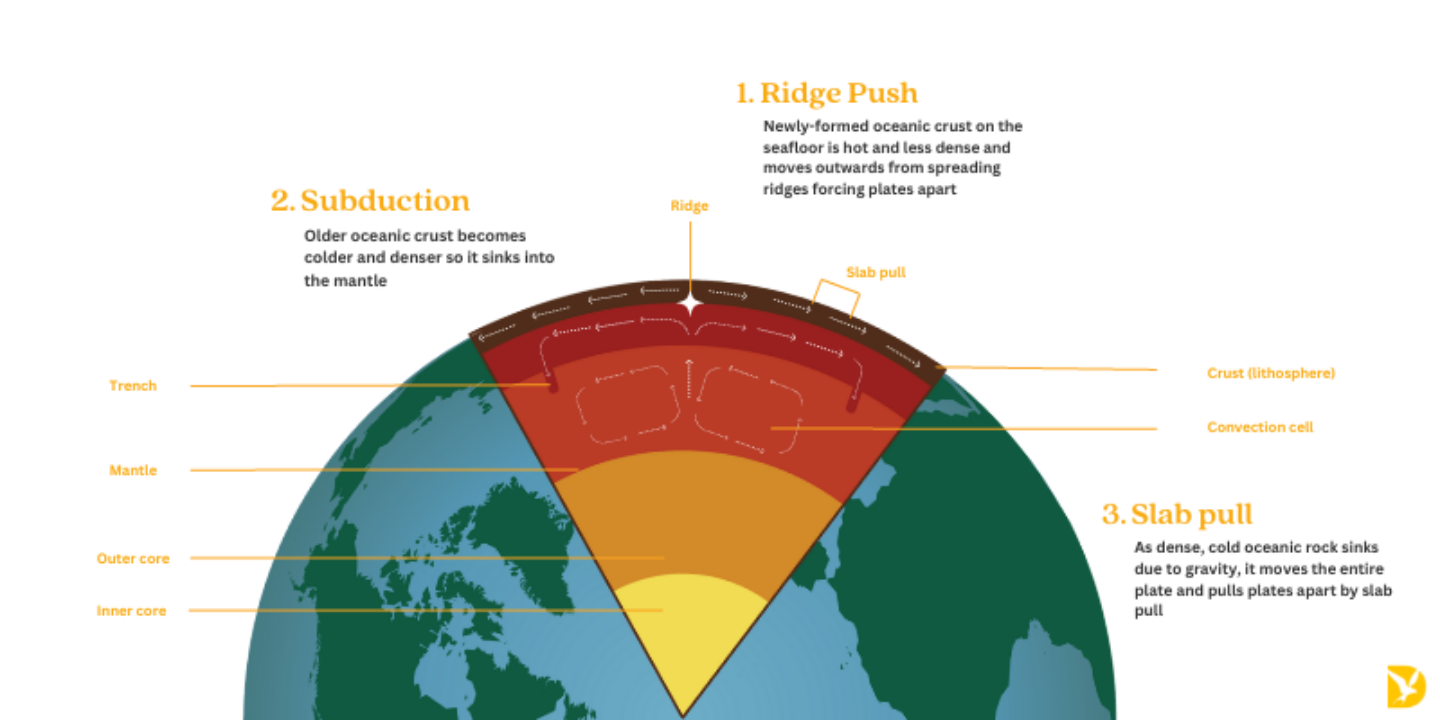
At the Mid-Atlantic Ridge, the Eurasian and North American plates are forced apart due to ridge push along the sea floor as it spreads newly formed oceanic crust (which is hotter and less dense than the surrounding crust), this then moves away from the spreading ridge until it also cools and becomes denser, driving the plates apart under gravity.
This ridge push and diverging plate action allow magma to reach the surface of Iceland. The hotspot Iceland plume further increases volcanic activity due to higher temperatures in the mantle below.
The 2021 Fagradalsfjall eruption in the same area, caused another part of the activity. The eruption caused a fissure to open close to Litli Hrútur volcano and produced firey fountains in true Icelandic style.
In a nutshell:
- Tectonic plates are not merely passengers riding along the mantle, they play an active part in plate movement through slab pull and ridge push
- Slab pull works in conjunction with convection, as plates cool and become more dense forcing them to sink into the mantle and drag the plate along behind them
- Iceland sits on the Iceland plume hotspot, an area of unusually hot mantle
- Litli Hrutur is part of the Fagradalsfjall volcano complex which sits along the southwest rift zone in Reykjanes. The spreading rift allows magma to the surface forming a fissure. The fissure is considered to be a branch of the larger Krýsuvík–Trölladyngja volcanic system
- The Fagradalsfjall area is interconnected, forming different eruptions along the fissure over time
What are the impacts of the volcanic eruption?
Explosive eruptions can impact the environment and local community and the level of this impact depends on a wide variety of factors. Let’s look at some of the primary and secondary effects of the Litli Hrutur eruption so far.
Primary effects are the direct result of a volcanic eruption, for example, buildings collapsing due to the movement of the earth.
Secondary effects occur because of the primary effects, for example, homelessness caused by the loss of buildings.
Primary effects
Volcanoes typically produce an array of primary impacts, including lava flows, ash columns, earthquakes, gas emissions, and pyroclastic clouds, pyroclastic flows to name a few.
Fortunately, Reykjanes peninsula is a remote area, approximately 30km southwest of the capital Reykjavik, and poses no significant danger to homes or infrastructure.
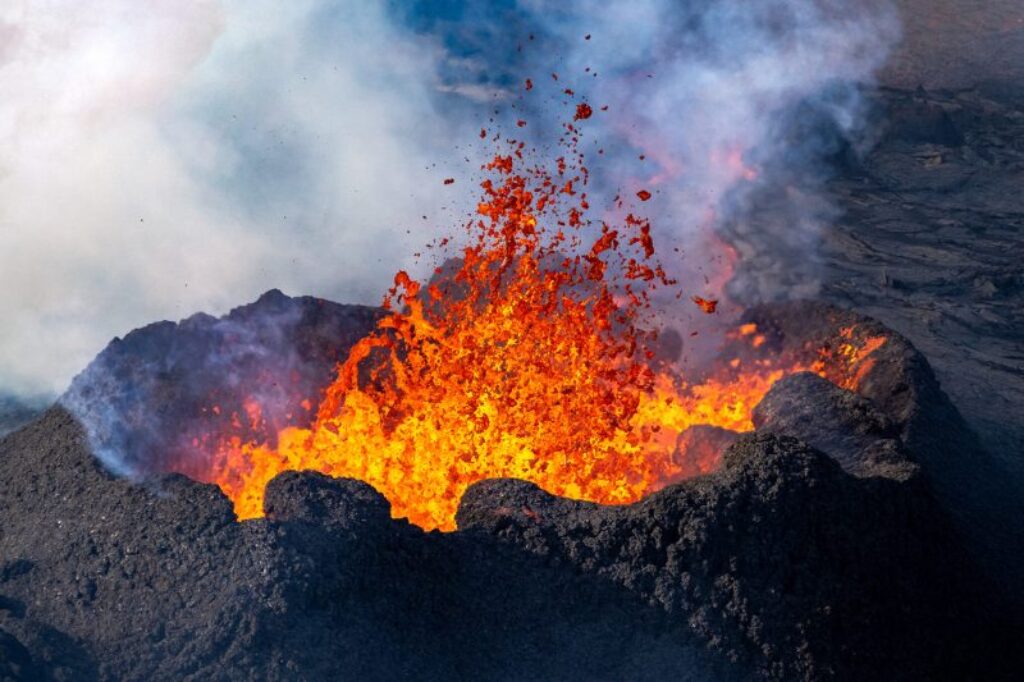
The eruption is an effusive fissure eruption of basaltic lavas, meaning that activity is limited to small fire fountains and no explosions, ash production is minimal, and there is no eruption column.
The primary impacts of the Litli Hrútur eruption are:
- Fluid pahoehoe-style lava flows
- The eruption has produced smoke and toxic gas emissions, which can cause respiratory issues
- Lava flows, which were more rapid in comparison to the 2021 eruption, now average 13 cubic metres per second (comparable to the previous eruption’s peak). The total volume of lava is currently 3.4 million cubic metres, covering 0.4 square kilometres so far
- Lava is flowing south along the Litli Hrútur Valley
- Activity has concentrated into one crater, building a small cone, as the 900m long fissure begins to close
Secondary effects
It’s currently too early to say much about the secondary effects of the eruption but since there is minimal ash or steam production and no interaction with ice (unlike the infamous Eyjafjallajökull eruption) there will be no risk or interruption to air travel. Here are some of the secondary effects so far:
Wildfires
Encroaching lavas triggered wildfires over the surrounding grasses and moss fields, causing smoke and further risk to hikers with reduced visibility and poor air quality. Firefighters from Grindavik have been working to reduce the spread of the wildfires.
Toxic gas emissions
Volcanic gas emissions can cause serious risks to respiratory health, therefore authorities are advising people to avoid the area when concentrations are too high and to wear masks when trekking is permitted.
The lack of winds in the early days of the eruption meant that gases were not being dispersed, and there were evacuations of hikers who were in danger.
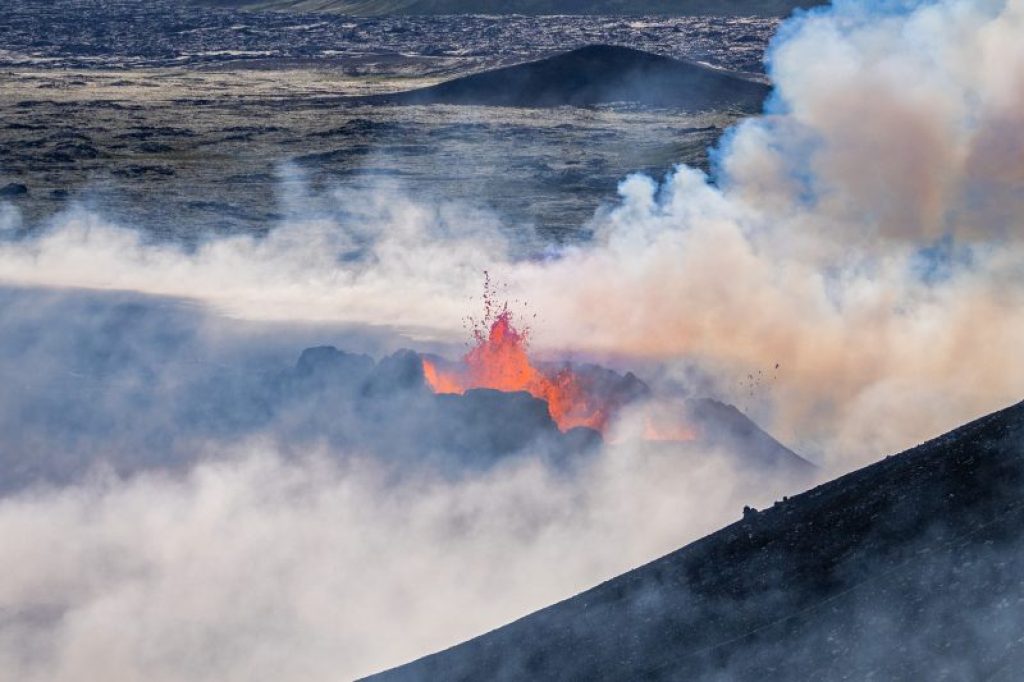
Tourist pressure on vulnerable ground
Due to the excitement of the eruption, tourists are keen to visit the volcano. The increasing pressure on the vulnerable ground (including pressure on roads and parking off-road) could increase erosion and cause environmental damage.
Some tourists made dangerous decisions to go too close to the volcano (with some attempting to climb the erupting crater!) leading to the site closing.
The good news is that increasing tourism from international visitors will bring additional revenue to Iceland.
Mitigation & Management
Iceland’s authorities are well-experienced in monitoring volcanic hazards allowing scientists to complete computer modelling to inform their predictions and planning. Examples of their preparation include:
- Seismic monitoring (which increased during the 2021 eruption)
- Ground deformation
- GPS measurements
- Thermal cameras
- Gas monitoring
Although it was impossible to give an exact start date for the eruption, authorities had already warned it was looming, raising the alert code to orange then red, and issuing notices about rockfalls and toxic gas emissions.
Locals observed an ‘orange glow’ in the distance, so coastal helicopters flew over the site to confirm an eruption had begun. Immediately automated text messages informed the public of an eruption.
Search and rescue ICE-SAR teams are present and have been working round the clock to ensure trails are as safe as possible or closed when necessary, however, conditions can change quickly depending upon winds and lava activity.
Weather forecasting is a critical part of the management, and the Met Office website and live streams share information on winds, precipitation and the impact on gas concentration in the area.
The biggest risk to public safety is hikers getting into trouble by entering the area when it’s closed off, using an unsafe path, or getting too close to lava flows, wildfires or gas vents. As a result, management is focusing on spreading accurate information through the media, online and on-site.
Media outlets installed webcams for continuous live streams around the area:
https://www.youtube.com/watch?app=desktop&v=yJfiMhqLgTY
How long will the Iceland eruption last?
Although it’s impossible to say how long the Litli Hrutur eruption will last, the geological history of Iceland is well documented and nearby eruptions can give us some clues. The eruption at Geldingadalir Fagradalsfjall in 2021 lasted six months and the 2022 eruption in the adjacent Meradalir Valley lasted just 18 days. Icelandic authorities and academics are well-versed in monitoring, modelling, and making predictions and it’s estimated that the eruption could last anywhere from “a few days to more than half a year.”
Many agree that this new activity must signify that the Reykjanes region has entered a new volcanic period, meaning intermittent eruptions could last 200-500 years!
Good to Know Facts
Where is the eruption located?
Litli Hrútur is part of Fagradalsfjall volcano complex, located in the Reykjanes Peninsula (aka the Sudarnes or Southern Peninsula) in southwest Iceland. Lili Hrutur is an active volcanic fissure and tuya system in a zone rifting over the Eurasian-North American divergent plate boundary.
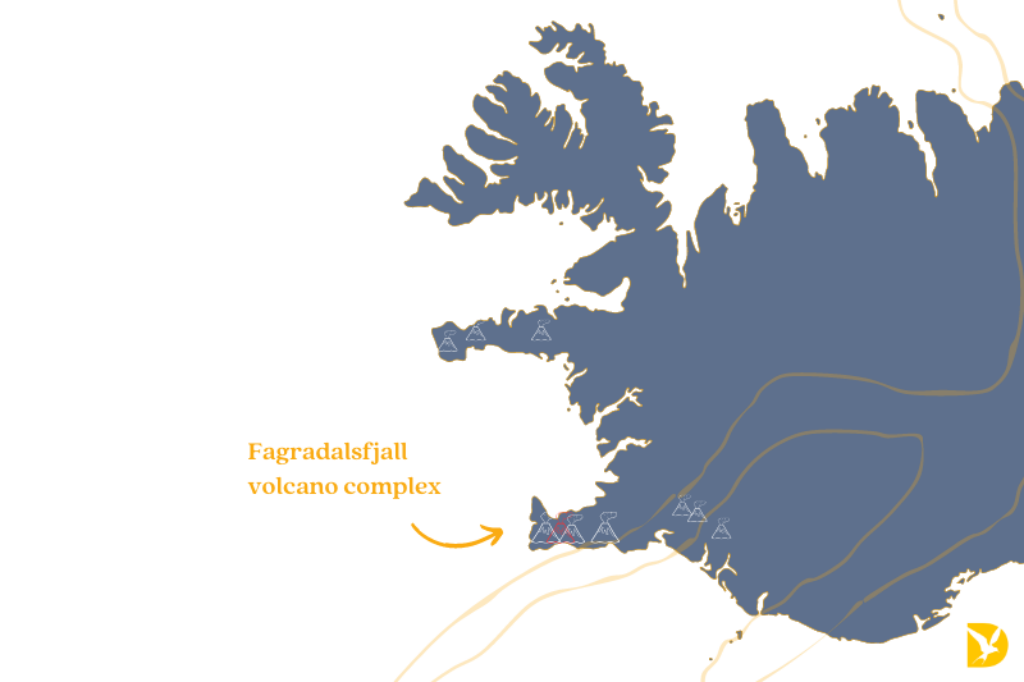
How often does an eruption happen?
On average there is an eruption every five years in Iceland, but these vary in scale and impact. Although the Reykjanes area experienced regular eruptions throughout the Holocene, the Fagradalsfjall 2021 eruption was the first in this dormant zone for 6342 years!
How big is the volcano?
Unusually for Iceland, which more commonly sees stratovolcanoes (composite) or cinder cones, the 2021 Fagradalsfjall eruption built a small shield volcano 385m high due to the length of the eruption of thin spreading lavas building layers over time.
The new Litli Hrútur eruption is currently forming a small cinder cone – but who knows what might happen depending on the eruption duration and magma composition!
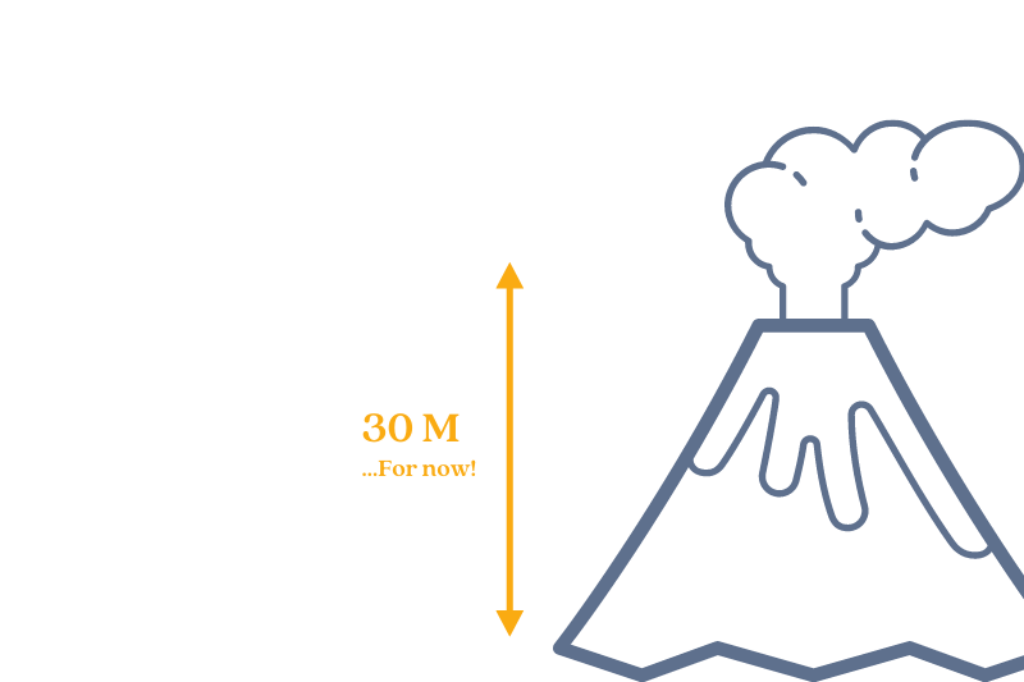
What is the geology of Iceland?
Due to its volcanic history, Iceland’s geology is dominated by igneous rocks formed over millions of years of eruptions. Reykjanes, like most of Iceland, is most formed from basaltic lava. This influences eruption style, with basaltic lava having lower silica content leading to more gentle effusive eruptions with thin runny pahoehoe-style flows.
Can people visit the volcano?
The 2021 and 2022 eruptions famously turned the area into a ‘Volcano Disneyland’ as the lavas contained within a valley made it suitable for spectators. Trips to the ‘hraun’ (lava fields) were created for tourists or scientists studying volcanic behaviour. This current eruption is being managed to reduce risk, but there are opportunities to hike to the volcano (a 20km round trip on foot) or take helicopter tours. However, visitors must respect this new fragile landscape, and the dangers posed.
Authorities closed the zone due to high gas emissions and wildfire smoke, and some hikers had to be rescued, so it’s critical to follow advice first before travelling.
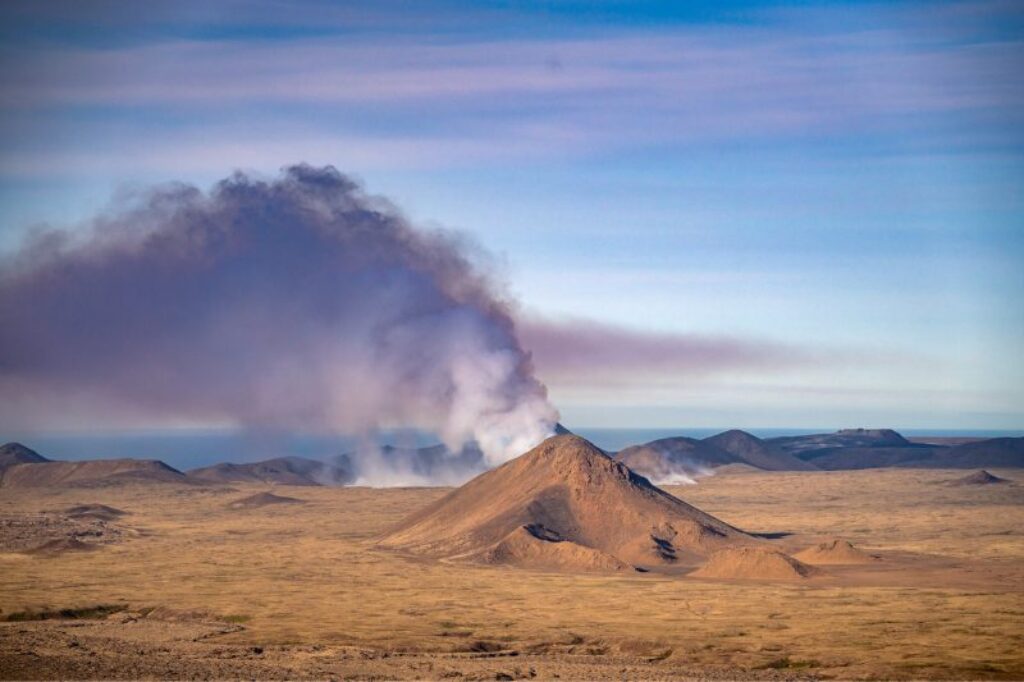
This eruption is another instalment in the evolving Fagradalsfjall volcanic story and one which draws attention across the world. It is not likely to have particularly dramatic impacts, but as a case study to consider management and the involvement of tourism, this is an excellent area to consider and to visit!
The spreading lava field could continue to grow and exceed the original 2021 event, or dwindle… We just don’t know.
FAQs
Where is the Iceland volcano eruption?
The current eruption in Iceland is located at Litli Hrútur, part of the Fagradalsfjall volcano complex, in the Reykjanes peninsula in southern Iceland.
How long will the Iceland eruption last?
It is unknown how long the eruption will last. The 2021 original eruption lasted 6 months (181 days), and the 2022 eruption lasted just 3 weeks.
When was the last eruption in Iceland?
The second Fagradalsfjall eruption (at Meradalir fissure) was from 3-21 August 2022, following a break of 319 days from the original Geldingadalir Fagradalsfjall eruption of 19th March – 18th September 2021. (The current eruption started 323 days after the second finished.)
Can I watch an Iceland eruption live stream?
Yes, you can watch the Iceland eruption live stream here.
